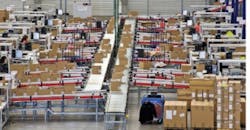Multilingual voice controls, the Internet of Things (IoT) and emerging technologies are adding new efficiencies to the modern warehouse in a climate of rising costs, according to a new JLL report.
Even as operators introduce more warehouse technology, many are also adding employee quality-of-life enhancements to counteract labor shortages.
"Technology is transforming every aspect of the warehouse—from tracking inventory to product picking—to get goods in and out as quickly and cost-effectively as possible," said Rick Steger, national Industrial Project Management lead, JLL. "As operators face rising costs and a shrinking inventory of prime land, the continued demand for space and labor is spurring innovation that now defines how warehouses are being built."
With warehouse vacancy rates below 3% in the top logistics markets, industrial developers are rethinking warehouse design to help e-commerce distribution companies and other users shrink their supply chain footprints.
Despite the 239.1 million square feet of warehouse space under construction in the second quarter of 2018—a 3.7% increase from the previous quarter—development can't always keep up with the demand for facilities.
The absence of prime developable land, along with the growth in demand for last-mile distribution facilities, is making small and mid-sized buildings the industry norm. Approximately 60% of new warehouse development comprises facilities in the 50,000- to 250,000-square-foot range.
JLL identified nine of the most promising features that will make the largest impact on warehouse efficiency:
1) Wireless technology and real-time inventory tracking: Warehouse operators are adopting new technologies to build efficiency into every aspect of the warehouse. Radio frequency identification (RFID) tags attached to each inventory item can transmit real-time data to and from the warehouse floor and inventory management applications, allowing warehouse teams to use mobile devices to track inventory from the moment it arrives.
2) A hyper-connected facility: In a hyper-connected warehouse, operating systems are laid out in a highly advanced matrix to accommodate the growing mix of technologies. Today's warehouses hold bandwidth for technologies like barcoding, IoT, RFID scanning, GPS, load optimization and future technology innovations that may emerge. With this tech in place, logistics managers can quickly make and execute decisions.
3) The new forklift: Forklifts, always a familiar sight in warehouses, are more connected than ever. IoT technologies can connect a warehouse operator's forklifts with their enterprise resource planning system and workers across the warehouse, shaving operations time. Some forklift manufacturers are incorporating alternative fuel systems and energy-efficient engines to reduce energy costs.
4) Growing clear heights: To optimize warehouse utilization, yesterday's 24- to 26-foot ceiling height has risen to the 36- to 40-foot range today. One reason is that automated picking technology can easily reach even the highest shelves. Another is that today's lighting systems can efficiently illuminate tall spaces. Yet a third factor is the availability of fire-suppression technologies that can reach higher ceilings.
5) Picking tech, picking up speed: From multilingual voice-picking and augmented reality to specialized robots, revolutionary technologies are changing picking practices. These technologies enable logistics operators to expand their labor pools by overcoming language barriers and accommodating a range of skillsets.
6) Sustainability, making strides: Alternative energy and energy efficiency are no longer optional as warehouse operators bring more automation into the warehouse. Solar panels, LED lighting, cool-roof systems, thermal glass, clerestory windows and other new green materials and innovations are leading warehouses into a new age.
7) Human-centric design: As labor shortages rise in many markets, there is a growing importance on workers' quality of life in the warehouse. New features such as effective lighting, air quality sensors and temperature control are more common as design becomes more human-centric. Improving the working environment not only benefits employee health but also reduces employee turnover and facilities risks.
8) When it comes to land, flexibility is the name of the game: Industrial tenants are demanding flexibility in response to highly variable business conditions. Tenants want the option to add land and space if additional needs arise, like a seasonal rush. "Flex land" could be deployed for needs such as additional truck storage or warehouse expansion.
9) Super-flat to sloped floors: The super-flat floor has long been the norm in warehouses. Although many warehouse operators continue to require exceptionally flat floors for highly precise robotic picking and racking technology, sloped floors are appearing to accommodate technologies for moving inbound and outbound shipments.
